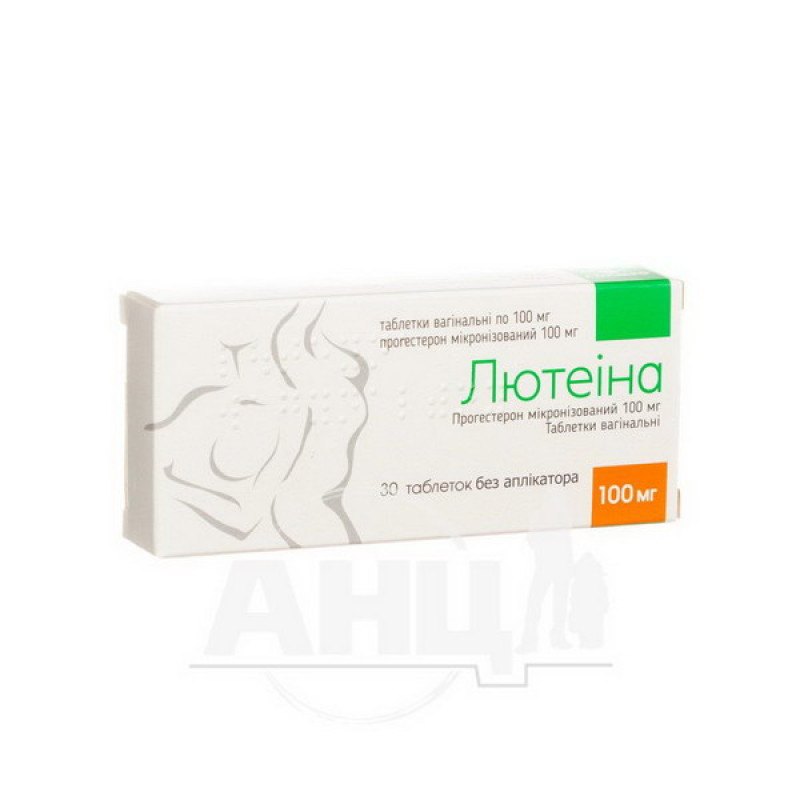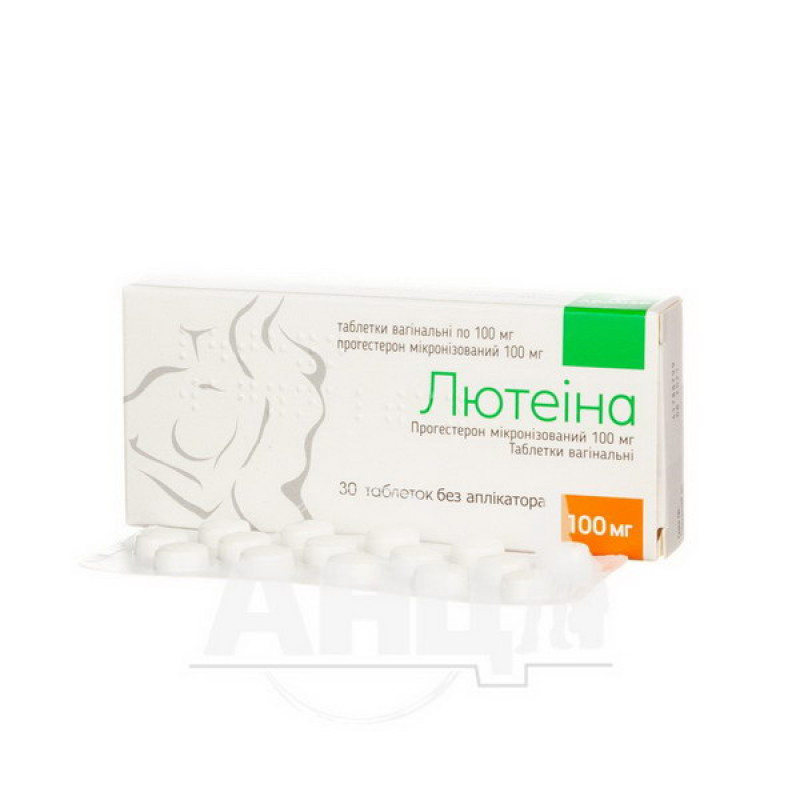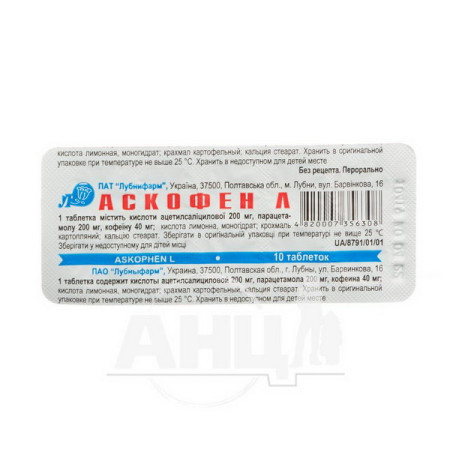Lutein vaginal tablets 100 mg blister without applicator No. 30

Instructions for Lutein vaginal tablets 100 mg blister without applicator No. 30
Composition
active ingredient: progesterone;
1 tablet contains 100 mg or 200 mg of micronized progesterone;
Excipients: lactose monohydrate, pregelatinized corn starch, croscarmellose sodium, hypromellose, citric acid monohydrate, magnesium stearate, colloidal anhydrous silicon dioxide.
Dosage form
Vaginal tablets.
Main physicochemical properties: 100 mg vaginal tablets: round, uncoated, biconvex, white or off-white tablets with the inscription "100" on one side and "22" on the other;
200 mg vaginal tablets: round, uncoated, biconvex, white or off-white tablets.
Pharmacotherapeutic group
Sex hormones and drugs used in pathologies of the genital area. ATX code G03D A04.
Pharmacological properties
Pharmacodynamics.
Progesterone is a hormone of the corpus luteum of the ovary. It contributes to the formation of a normal secretory endometrium in women. It causes the transition of the uterine mucosa from the proliferation phase to the secretory phase, and after fertilization, it promotes its transition to the state necessary for the development of a fertilized egg. It reduces the excitability and contractility of the muscles of the uterus and fallopian tubes, stimulates the development of the terminal elements of the mammary gland. It has no androgenic activity. It has a blocking effect on the secretion of hypothalamic LH and FSH releasing factors, inhibits the formation of gonadotropic hormones by the pituitary gland and ovulation.
Pharmacokinetics.
After insertion into the vagina, progesterone is rapidly absorbed by the mucous membrane.
The increase in plasma progesterone levels begins within the first hour, with the highest plasma levels being reached 1–3 hours after administration.
At a dose of 100 mg of progesterone per day, Lutein allows you to achieve and maintain a physiological and stable level of plasma progesterone (on average at 9.7 ng/ml), similar to that in the luteal phase of the menstrual cycle with normal ovulation. Thus, Lutein stimulates adequate maturation of the endometrium, promotes embryo implantation.
At higher doses (above 200 mg per day), which are increased gradually, the vaginal route of administration allows achieving plasma progesterone levels similar to those during the first trimester of pregnancy.
Metabolism.
The metabolites in plasma and urine are identical to those found during physiological secretion of the corpus luteum: in plasma, these are mainly 20α-hydroxy, δ4α-pregnanolone and 5α-dihydroprogesterone. Urinary excretion is 95% in the form of glucuronic metabolites, the main component of which is 3α, 5β-pregnanediol (pregnanediol).
Indication
Reduced ability to fertilize in primary or secondary infertility with partial or complete luteal insufficiency (dysovulation, luteal phase support during preparation for in vitro fertilization, egg donation program). Prevention of habitual miscarriage or threatened spontaneous miscarriage in luteal insufficiency. Prevention of premature birth in women with a short cervix or in women with a history of premature spontaneous birth. Impossibility or limitation of oral use of the drug.
Contraindication
Hypersensitivity to any of the components of the drug. Severe liver dysfunction. Suspected or confirmed neoplasia of the breast or genitals. Undiagnosed vaginal bleeding. Failed or incomplete abortion.
Thrombophlebitis. Thromboembolic disorders. Cerebral hemorrhage. Porphyria.
Interaction with other medicinal products and other types of interactions
No clinically significant interactions of progesterone with other drugs have been reported. In vitro studies have shown that drugs that reduce cytochrome P450 activity (e.g. ketoconazole) may slow the metabolism of progesterone. The clinical significance of this effect is unknown.
Antisteroid drugs: Aminoglutethimide markedly reduces the plasma concentrations of medroxyprogesterone acetate and megestrol, possibly through a hepatic enzyme-inducing effect.
Anticoagulants: Progesterone may enhance or reduce the anticoagulant effect of coumarins.
Progesterone antagonizes the anticoagulant effect of phenindione.
Emergency contraceptives: Concomitant use of ulipristal acetate with progesterone may result in reduced efficacy of progesterone.
Diazepam: Progesterone may increase the plasma concentration of diazepam.
Tizanidine: Progesterone may increase the plasma concentration of tizanidine.
Terbinafine: There have been isolated reports of breakthrough bleeding when terbinafine is used concomitantly with progesterone.
Laboratory tests: Progesterone may affect the results of laboratory tests of hepatic and/or endocrine function.
The administration of large doses of progesterone may temporarily lead to increased excretion of sodium and chlorine.
Progesterone use may increase plasma concentrations of cyclosporine. Some antibiotics (e.g. ampicillin, tetracycline) may cause changes in the intestinal microflora, resulting in altered enterohepatic steroid cycling.
Potent inducers of hepatic enzymes, namely: barbiturates, antiepileptic drugs (phenytoin, carbamazepine), rifampicin, phenylbutazone, bromocriptine, spironolactone, griseofulvin, nevirapine, efavirenz, some antibiotics (ampicillins, tetracyclines), as well as herbal preparations containing St. John's wort (Hypericum perforatum), may increase the metabolism and elimination of progesterone. Ritonavir and nelfinavir are known to be potent inhibitors of cytochrome enzymes, exhibiting enzyme-inducing properties when used concomitantly with steroid hormones.
Application features
Use in recommended doses does not demonstrate a contraceptive effect.
If treatment is started too early in the menstrual cycle, especially before day 15 of the cycle, a shortened cycle or bleeding may occur.
In case of uterine bleeding, do not prescribe the drug without clarifying its cause, in particular during endometrial examination.
It should be used with caution in patients with fluid retention (e.g., in case of hypertension, cardiovascular disease, kidney disease, epilepsy, migraine, bronchial asthma), with a history of depression, diabetes mellitus, liver dysfunction, and photosensitivity.
Before prescribing the drug, patients with a family history of neoplasms and patients with recurrent cholestasis or persistent itching during pregnancy, impaired liver function, heart or kidney failure, fibrocystic mastopathy, epilepsy, asthma, otosclerosis, diabetes mellitus, multiple sclerosis, systemic lupus erythematosus should be carefully examined.
Due to the thromboembolic and metabolic risk, which cannot be completely ruled out, the drug should be discontinued in the event of:
– visual disturbances, such as vision loss, double vision, retinal vascular lesions, proptosis, optic disc edema;
– thromboembolic venous or thrombotic complications, regardless of the site of the lesion;
– severe headache, migraine.
If amenorrhea occurs during treatment, pregnancy, which may be the cause of amenorrhea, should be confirmed or ruled out.
More than half of early spontaneous abortions are caused by genetic complications. In addition, infectious manifestations and mechanical disorders can be the cause of early abortions. The only justification for prescribing progesterone in this case is to delay the rejection of a frozen embryo. Therefore, prescribing progesterone on the recommendation of a doctor should be provided for cases when progesterone secretion is insufficient.
Before starting treatment, the patient should undergo a thorough medical and gynecological examination, including intravaginal and mammological examination, Papanicolaou smear, taking into account the anamnesis, contraindications and precautions for use. Regular check-ups with a doctor are recommended during treatment. Women receiving hormone replacement therapy should carefully assess all the risks/benefits associated with therapy.
The physician should discuss the higher likelihood of developing breast cancer with patients who will receive long-term hormone therapy.
Use during pregnancy or breastfeeding
The use of progesterone is not contraindicated during pregnancy, including the first weeks (see the "Indications" section).
During the period of use of the drug, no case of adverse effects of the drug on the fetus was observed.
When using the drug in the second and third trimesters of pregnancy, liver function should be monitored.
The passage of progesterone into breast milk has not been studied in detail. Therefore, its administration should be avoided during breastfeeding.
There is evidence of the possible development of hypospadias when progestogens are used during pregnancy to prevent spontaneous abortion or threatened abortion due to luteal insufficiency, which the patient should be informed about.
Ability to influence reaction speed when driving vehicles or other mechanisms
Due to the possible occurrence of drowsiness and impaired concentration and attention, one should refrain from driving and working with other mechanisms. When using progesterone, dizziness, drowsiness, impaired concentration and attention are possible in isolated cases, which should be warned to the patient. Taking the tablets before bedtime helps to avoid these unpleasant consequences.
Method of administration and doses
The doses of Lutein in each case should be set individually, depending on the indications and therapeutic effect. For more convenient use by patients and adjustment of the dosage regimen, there are the following dosages of Lutein, vaginal tablets: 50 mg, 100 mg, 200 mg.
Vaginal tablets should be inserted into the vagina using the applicator provided in the package. For packages without an applicator: the tablets should be inserted deep into the vagina.
– In case of partial luteal phase insufficiency (dysovulation, menstrual cycle disorders), the daily dose is 200 mg for 10 days (usually from the 17th to the 26th day of the cycle).
– In case of complete luteal phase deficiency [complete absence of progesterone in women with non-functioning (absent) ovaries (egg donation)]: the dose of progesterone is 100 mg on the 13th and 14th days of the transfer cycle. From the 15th to the 25th day of the cycle, the dose of progesterone is 200 mg, which is divided into two doses (morning and evening). Starting from the 26th day, in case of early diagnosis of pregnancy, the dose is gradually (every week) increased by 100 mg of progesterone per day, reaching a maximum of 600 mg of progesterone per day in three doses. This dosage should be followed until the 60th day.
– Luteal phase support during an in vitro fertilization cycle: treatment is carried out starting from the evening of the embryo transfer day, at the rate of 600 mg per day in 3 doses (200 mg every 8 hours).
– Prevention of habitual miscarriage or threatened spontaneous miscarriage in luteal insufficiency: 200–400 mg per day (100–200 mg in one dose every 12 hours) up to 12 weeks of pregnancy.
– Prevention of preterm birth in women with a short cervix or in women with a history of spontaneous preterm birth: the dose is 200 mg per day and is administered in the evening before bedtime from the 22nd to the 36th week of pregnancy.
Children
There are no clinical data on the use of the drug in children.
Overdose
Overdose may manifest as symptoms of adverse reactions, including drowsiness, dizziness, euphoria, dysmenorrhea, decreased cycle length, and metrorrhagia.
For some individuals, the usual dose may be excessive due to existing or secondary unstable endogenous progesterone secretion, hypersensitivity to the drug, or very low concomitant blood estradiol levels.
In such cases you need:
– reduce the dose of progesterone or prescribe progesterone in the evening before bedtime for 10 days per cycle in case of drowsiness or transient dizziness;
– postpone the start of treatment to a later date in the cycle (for example, day 19 instead of day 17) in case of its shortening or bleeding.
Adverse reactions
During the use of Lutein, vaginal tablets containing progesterone identical to the endogenous hormone, side effects were observed sporadically.
In some cases, drowsiness, impaired concentration and attention, feelings of fear, depressive states, headache and short-term dizziness, insomnia, and increased fatigue were noted.
From the reproductive system: change in the menstrual cycle, amenorrhea, premenstrual symptoms, intermittent bleeding, mastodynia, changes in libido, breast discomfort; possible hypersensitivity reactions, including vaginal burning, hyperemia, itching.
Skin and Appendages: skin redness, acne; hypersensitivity reactions, including urticaria, rash, itching; alopecia, hirsutism, anaphylactic reactions, chloasma.
Gastrointestinal: nausea, gastrointestinal disorders, vomiting, diarrhea, constipation.
Hepatobiliary disorders: cholestatic jaundice.
From the vascular system: thrombosis, venous thromboembolism, pulmonary embolism.
Other disorders: fluid retention, hyperthermia.
Drowsiness and/or transient dizziness are observed especially in the case of concomitant hypoestrogenism. Reducing the dose of the drug or increasing the dose of estrogen immediately eliminates these phenomena without reducing the therapeutic effect.
If treatment is started too early in the menstrual cycle, especially before day 15, cycle shortening or spotting may occur.
The following side effects may also occur:
urticaria, pyrexia, irregular menstruation, breast pain, weight change, gallbladder disease, skin and subcutaneous disorders such as erythema multiforme, erythema nodosum, vascular purpura.
Expiration date
36 months.
Storage conditions
Store below 30°C. Keep out of the reach of children.
Packaging
Vaginal tablets 100 mg: 2 blisters No. 15 in a cardboard box together with an applicator marked "vaginal applicator 100".
Vaginal tablets 100 mg: 2 blisters No. 15 in a cardboard box without an applicator.
Vaginal tablets 200 mg: 3 blisters No. 10 in a cardboard box together with an applicator marked "vaginal applicator 200"; 2 blisters No. 10 in a cardboard box together with an applicator marked "vaginal applicator 200".
Vaginal tablets 200 mg: 3 blisters No. 10 in a cardboard box without an applicator;
2 blisters No. 10 in a cardboard box without an applicator.
Vacation category
According to the recipe.
Producer
Adamed Pharma JSC, Poland.
Location of the manufacturer and its business address.
St. Marsh. J. Pilsudskiego 5, 95-200, Pabianice, Poland.
There are no reviews for this product.
There are no reviews for this product, be the first to leave your review.
No questions about this product, be the first and ask your question.




